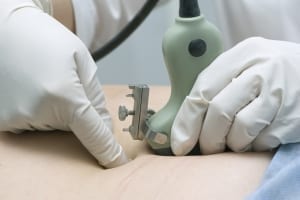Herzliya Medical Center
Tel: +972-9-959-4888
09:00-18:00
 Amniocentesis for every woman
Amniocentesis for every womanOne of the most familiar examinations out of the host of examinations performed when monitoring a pregnancy is amniocentesis, which can be used to identify genetic diseases, defects and even infections that have developed in the fetus’ body. Amniocentesis is perceived by many people as being somewhat frightening due to the increased risk of miscarriage that it entails, but if we look at the data in-depth, we will discover that the chance is very small: the numbers indicate a one half of one percent chance for miscarriage due to the examination.
All women may undergo amniocentesis, but only for certain women is it fully funded. The following are the cases in which the examination will not be funded from the patient’s pocket:
Amniocentesis, as mentioned above, an examination performed during pregnancy with the objective of identifying various genetic diseases or genetic defects. The examination can identify, among other things, Down’s syndrome in a fetus, cystic fibrosis, and more. This examination is very accurate and is not considered to be a statistical test or an estimate: by means of amniocentesis, it is possible in most cases to determine whether or not a genetic problem exists.
The examination is usually performed between Week 16 and Week 22 of pregnancy. By special approval, it can also be performed at much more advanced stages of pregnancy, even after Week 30 of pregnancy, for example. The examination is performed without any anesthesia, and usually hurts no more than a regular blood test.
You should bring the pregnancy monitoring card, and any document connected to pregnancy examinations performed thus far. There is no need for significant physical preparation before the examination, but it is recommended to visit the bathroom shortly before it commences so that the urinary bladder is empty and less “annoying”.
Amniocentesis takes a few minutes. During its course, some 25 cc of amniotic fluid is drawn out, using a thin needle that is introduced into the uterus via the abdominal wall. As mentioned above, the examination should not cause any pain and is completed within a very short time. The entire procedure is performed under ultrasound guidance, to make sure that the needle is introduced to the correct place, and in the safest manner.
The fluid that is drawn out is sent for laboratory testing. Since the fetus is surrounded by amniotic fluid throughout the pregnancy and develops in it, the fluid contains cells from its body – skin cells and the like – which contain its DNA. These cells are assessed using various genetic tests (karyotype, genetic chip, and FISH), with the objective of identifying various defects in the fetus’ genetic makeup. The amount of amniotic fluid drawn out during the examination is considered to be minute compared to the total amount of amniotic fluid in the uterus that surrounds the fetus. The “deficit” created will be unnoticeable, and will be replenished within a few hours naturally.
Side effects of the examination are perhaps the most worrying issue from the viewpoint of the women who are going to undergo the procedure, mainly the chance for miscarriage due to the examination. As mentioned above, this issue does indeed exist, but the chance for a miscarriage due to the examination comes to half a percent only. Furthermore, chorionic villus sampling (CVS), which is also considered to be a common test for identifying genetic defects, involves a risk that is twice a high as that for amniocentesis. An additional side effect of the examination is the development of infection in the uterus – therefore the needle and the place where it is introduced to the uterus are well disinfected prior to the commencement of the process.
In principle, it is recommended to rest for 24 hours after the examination, and not to exert oneself for 72 hours. If you experience effects such as severe vaginal bleeding, contractions, breaking of waters or fever after the examination, consult with the treating physician promptly so that he can check the reasons for this.